High Energy Giving Foods To Solve Your Energy Woes
By Mansi Shah +2 more

Get,

to manage your symptom
Get your,


4 Cr+ families
benefitted

OTP sent to 9988776655



You’ve successfully subscribed to receive
doctor-approved tips on
Whatsapp

Get ready to feel your best.

Hi There,
Download the PharmEasy App now!!


Register to Avail the Offer
Send OTPBy continuing, you agree with our Privacy Policy and Terms and Conditions

Hi There,
Sign up on PharmEasy now!!
Trusted by 4 crore+ families

OTP sent to 9988776655



You have unlocked 25% off on medicines




Code: NU25

Comments


Leave your comment here
By Mansi Shah +2 more
Table of Contents
During summer, the intense heat and constant exposure to the sun can lead to excessive perspiration, resulting in significant fluid loss. This often leaves one feeling fatigued and low in energy, making everyday tasks feel more demanding than usual.
However, maintaining your energy levels during this time can be supported through appropriate dietary choices. Certain high-energy foods can support your metabolism and also give you an energy boost. Here’s a list of top foods that may help increase your energy levels.
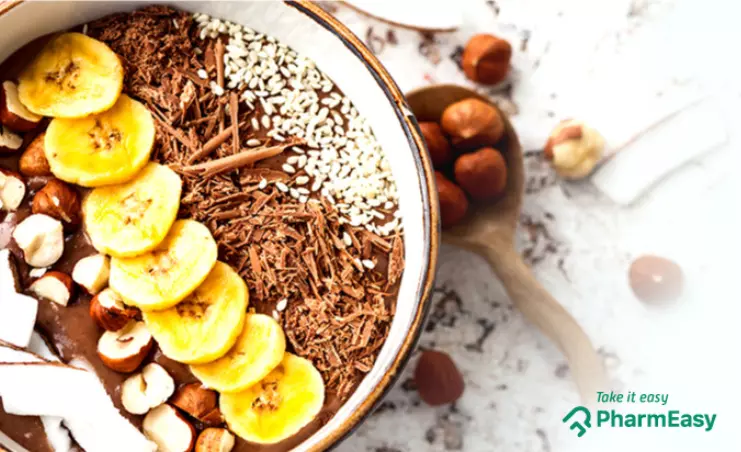

Bananas are naturally sweet fruits that can be a valuable part of an energy-supporting diet. They are a good source of potassium and dietary fibre, and they contain natural sugars such as glucose, fructose, and sucrose. These components are easily absorbed by the body and may help provide a feeling of sustained energy1. In addition to their carbohydrate content, bananas are rich in fibre, which supports healthy digestion. A well-functioning digestive system contributes to overall wellbeing, and many people find that a balanced diet including fibre-rich foods helps them feel more energised.
Bananas can be consumed in many forms. Green bananas are a great source of fibre as it contains resistant starch which helps with digestion, maintains blood sugar levels, and makes you feel full. On the other hand, ripe bananas are sweet and nutritious. They are a great source of vitamins and minerals like potassium and vitamin B6 and provide instant energy for physical activity.
Dr. Siddharth Gupta, B.A.M.S, M.D (Ayu)
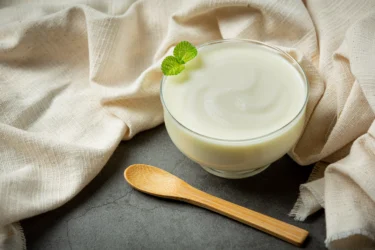
Dieticians and doctors emphasise the importance of consuming curd or yoghurt. It has a cooling effect on the body. Yoghurt is packed with magnesium, a mineral that instantly releases energy in the body, thus making it the ideal energy giving food3.
If you exercise during the summer months, it is beneficial to include yoghurt as part of your post-workout meals. Yoghurt is a good source of protein and can support the body’s recovery process after exercise, especially when included as part of a balanced diet.
In addition to its nutritional value, yoghurt is known for its cooling properties, making it a suitable dietary choice during hot weather. It also contains beneficial bacteria which may support digestive health. Many people find that yoghurt is gentler on the stomach and can serve as a suitable alternative to milk, particularly for those who experience discomfort from consuming milk directly3.

Coconut water is a cooling drink that can supplement your daily water intake. With a high water content and very little fat, it offers a light and hydrating option for those looking to stay cool and refreshed. It contains naturally occurring electrolytes such as potassium, magnesium, and sodium, which support the body’s fluid balance and may assist in maintaining optimal hydration levels, especially after physical activity. This makes coconut water a popular post-exercise drink during summer.
As a naturally occurring liquid found inside young coconuts, it is generally low in calories and fat. Due to its nutritional profile, it can be included as part of a varied and balanced diet, including for individuals managing their blood sugar levels. However, it is advisable to consult a healthcare professional regarding its suitability for specific health conditions5.

Dry fruits comprise dehydrated fruits like dates, raisins, cashews and apricots. Naturally sweet, they do not typically contain added refined sugars, making them a preferable option for those looking to reduce their intake of processed sweeteners. However, individuals with specific dietary requirements, such as those managing diabetes, should consult a healthcare professional before making significant changes to their diet.
These fruits contain natural sugars and vary in their glycaemic index, raisins have about 54, dates have 62, apricots have around 30. In addition to their natural sugar content, dry fruits are rich in potassium, dietary fibre, and a variety of vitamins, making them a nutrient-dense snack6.
Figs, for example, are often enjoyed as a wholesome snack, while prunes and raisins are commonly included in diets that aim to support digestive health. Apricots are also valued for their nutritional content and are sometimes used in skincare routines, though such uses should be approached cautiously and preferably under guidance6.
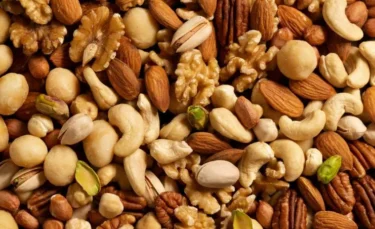
A notable quality of nuts is their ability to provide a consistent release of energy over time, rather than an immediate spike. This makes them an ideal snack for those seeking sustained energy throughout the day.
Pistachios and almonds are known as neutral foods, neither hot nor cold and make for good energy giving food during summers Nuts such as peanuts, almonds, cashews, and pistachios are rich in healthy fats, protein, and dietary fibre. These nutrients are digested slowly, which may contribute to prolonged satiety and help in maintaining steady energy levels7.

Chocolate contains sugar and caffeine, both of which may contribute to a temporary increase in energy by stimulating the release of hormones such as cortisol and adrenaline4. Consuming small portions of chocolate two to three times a day can offer a modest energy lift.
Additionally, chocolate contains antioxidants that are being studied for their potential to support cardiovascular health by contributing to the maintenance of healthy blood pressure and cholesterol levels.
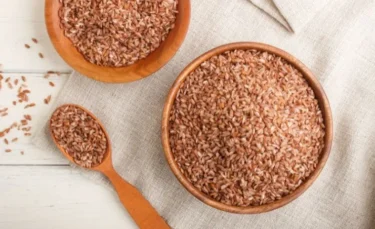
In addition to being highly nutritious, brown rice provides a substantial amount of energy and may help combat fatigue. It is a good source of manganese, a mineral that supports enzymes involved in breaking down carbohydrates and proteins to release energy. As brown rice is less processed than white rice, it retains a greater proportion of its natural nutrients9.

Eggs are not only delicious but also packed with protein, making them an excellent source of sustained energy. They contain leucine, an amino acid that plays a role in stimulating energy production within the body. Additionally, are rich in vitamin B complex, which supports the metabolic processes involved in converting food into energy11.
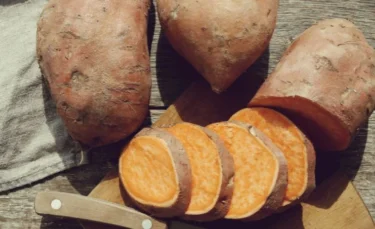
Sweet potatoes contain complex carbohydrates and fibre, which are digested slowly by the body, providing a steady and lasting source of energy. They are rich in manganese, a mineral that aids in the breakdown of nutrients to produce energy. A medium-sized sweet potato typically contains around 100 calories, 23 grams of carbohydrates, 4 grams of fibre, and 2 grams of protein12.
One of the advantages of these nutrient-dense foods is their versatility. They can be enjoyed individually or combined to create delicious fruit and nut bowls or homemade energy bars. Such combinations offer not only wholesome nutrition but also satisfying flavours that help curb hunger, support hydration, and keep you feeling refreshed on hot and humid days.
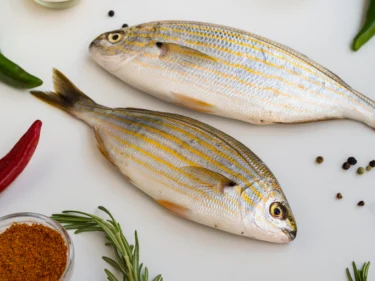
Fatty fish such as salmon and tuna are great sources of protein, fat, and omega-3 fatty acids. Including these fish in your diet can help meet your omega-3 requirements, which are known to support the reduction of inflammation, a common factor contributing to fatigue. This is particularly important for individuals recovering from illnesses such as cancer13.

Coffee provides a rapid energy boost due to its high caffeine content, which quickly enters the bloodstream and reaches the brain. Consumption of coffee stimulates the production of epinephrine, a hormone that activates both the body and mind, enhancing alertness and energy levels7.

Avocado is regarded as a superfood due to its numerous health benefits. It is rich in healthy monounsaturated fats, which help maintain optimal blood lipid levels and support heart health. Additionally, avocados provide essential vitamins, minerals, and fibre, contributing to overall wellbeing and sustained energy.
About 84% of the healthy fats in avocados come from monounsaturated and polyunsaturated fatty acids. Additionally, the fibre in avocados accounts for 80% of their carbohydrate content14.
Eating avocados daily might have positive effects on weight loss, in addition to improving body composition and metabolic parameters.
Dr. Rajeev Singh, BAMS
Also Read: Top Food Sources of Calcium for Your Bones
As with any diet plan, there are certain foods you should avoid, as they may slow down your metabolism and do not provide a sufficient energy boost.
Also Read: 11 Healthy Foods That Can Help You to Gain Weight
Choosing the right foods during summer can help maintain energy levels, support metabolism, and promote overall wellbeing. Nutrient-dense options like fruits, nuts, and whole grains are beneficial, while highly processed or sugary foods should be limited. A balanced diet is key to staying energised and resilient in the heat.
Also Read: Ajwain: Uses, Benefits, Side Effects, and More!
Disclaimer: The information provided here is for educational/awareness purposes only and is not intended to be a substitute for medical treatment by a healthcare professional and should not be relied upon to diagnose or treat any medical condition. The reader should consult a registered medical practitioner to determine the appropriateness of the information and before consuming any medication. PharmEasy does not provide any guarantee or warranty (express or implied) regarding the accuracy, adequacy, completeness, legality, reliability or usefulness of the information; and disclaims any liability arising thereof.
Comments

Leave your comment...

View all comments(3)
You may also like
This was very informative. Every day we eat food but without the knowledge of vitamins in it. Thank you for sharing.
Appreciate your support on the blog. Stay tuned for more such original articles.
Thank you. Please stay tuned for more such articles.